BLACKPOOL GAZETTE & NEWS 19 JUNE 1885
FETE AT ST. ANNES.
------------------ - -----------------
OPENING OF THE NEW PIER.
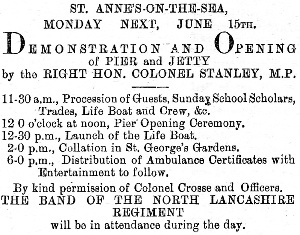
The latest witness to the development of St. Annes-and, may we not hope,
the certain prelude to its increased popularity— was on Monday converted into the occasion for a
general holiday amongst our neighbours to the south, and the prime movers in the demonstration
which then took place are to be congratulated upon the signal success which crowned their
labours.
The acquisition of a pier to St Annes is indeed a new landmark in the
history of the town, and therefore fuller and more complete prosperity is likely to date from the
proceedings on Monday. The formal opening of the new structure was deputed to Colonel the Right
Hon. F. A. Stanley, M.P., and the favourable auspices under which the ceremony was consummated must
afford pleasurable reflections to all concerned.
The Pier seems to have been evoked by reason of the rapid growth of the
place, and its existence is a definite assertion of the enterprise which has thus far dominated the
development of St. Annes. The little town is a fine example of latter-day tendencies in respect of
seaside resorts, and after the flattering recognition accorded to it on Monday, it is more than
likely that efforts will be made to sustain the impression then made, and to secure a repetition of
what is at present a unique experience.
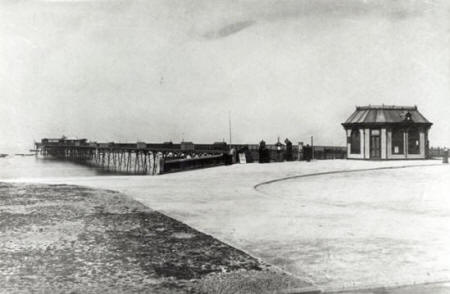
As a witness to progress, however, the place deserves special notice. Out of what was but ten or
twelve years ago a mere stretch of barren sand, the enterprise of a few capitalists, assisted and
encouraged by liberality on the part of the owners of the estate, has developed an admirably
laid-out seaside town, with a population in the Local Board district of which it is the centre of
nearly 2,090.
St. Annes has a capital Promenade, 3,000 feet long and 180 feet wide, and
its streets are broad and well arranged, with a number of substantial villa residences. For all its
advantages of arrangement and design it in indebted to the Land and Building Company, and to this
same source is also traceable the construction of the new Pier and extension. This structure has
been erected at a cost of £18,000, and the public spirit displayed by its projectors is deserving
of all praise. It is 360 yards long, and though very substantially built has a light and graceful
appearance. The Pier is furnished with recesses and seats, and at the outer end there is a covered
shelter and a band stand. From the pier, head there is three-storeyed iron extension which will
enable passengers to embark or disembark at all states of the tide, and in the roughest
weather.
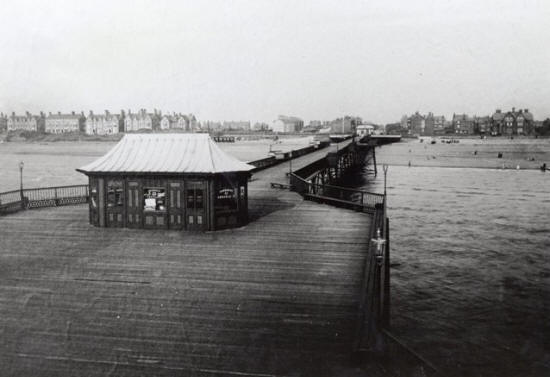
The engineers for the jetty were Messrs. Garlick & Sykes, of Preston,
and the work has been satisfactorily carried out by Messrs William Alsup and Sons, contractors, of
Preston. The Pier, as a whole, is from the designs of Mr A. Dowson C.E., Westminster, and its
construction has been effected under his superintendence. In a score always it increases the
importance of St, Annie, but as a convenience to those who reside there, and who are of a nautical
turn, its value cannot be over-estimated. From a purely picturesque point of view, however, it is
graceful addition to the front, whilst on the more practical score of utility it gives raison
d'être to the Promenade by affording not only a means of embarkation but also a further marine
parade.
THE OPENING CEREMONY.
Although there was nothing exceptionally interesting in the programme arranged— there was an
interest in the occasion which attracted a met concourse of people. Never before has St.Annes had
its resources taxed so completely, and never before has it had so many visitors within its borders.
In truth, the very promoters of the demonstration must have been gratified beyond anticipation, for
expectation could hardly run riot to the tune of converting St. Annes into a second edition of
Blackpool. Such was the case, though, and unless opportunities for a “general“ holiday are
multiplied, St. Annes will have to wait a while for such another day.
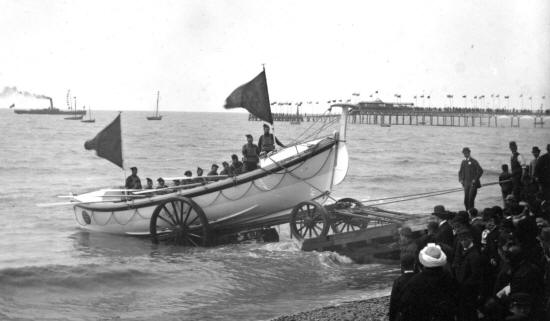
Mr. Porritt, chairman of the company, and under whose presidency the
festivities were consummated swelled the throng by bringing his workmen (360 in number) from
Helmshore. Blackpool and Lytham contributed large contingents, and Southport was not unrepresented.
Inland towns contributed their quota to the guests, and taken generally the town secured a very
mixed publicity. There was a liberal display' of bunting on every available station, and the Pier
especially was decorated in an effective manner.
The inaugural portion of the “show” took the form of a procession, and in
the direction of this, and in the other arrangements of the day, Mr. Nutter (secretary of the Land
and Building Company) was particularly active and energetic. The varying elements were marshalled
near the St. Annes Hotel at half-past eleven, and proceeded thence to the Pier, headed by the
capital band of the 3rd and 4th Battalion Loyal North Lancashire Regiment, under the conductorship
of Mr. Norwood.
Next after the band came the St. Annes Lifeboat, given some time ago by
Mr. Chadwick, of Manchester, drawn by six gaily caparisoned horses, with the crew in their
picturesque scarlet caps and cork jackets ; then the local ambulance corps, with their uninviting "
appliances," which seemed out of place on such a festive occasion ; the Chairman and Directors of
the Land and Building Company, and the Secretary, Mr. W. H. Nutter ; pier engineers and the clerk
of works : members of the Local Board, Sunday scholars, workmen representing various trades,
members of the Clifton Industry Lodge of the Independent United Order of Mechanics, headed by the
handsome two-poled banner belonging to the Fylde district, and the St. Annes Subscription Brass
Bend : invited guests, representatives of the estate, and Mayors of various Lancashire boroughs.
The Church of England Sunday scholars were accompanied by the Rev. W. G. Terry, Vicar of St. Annes,
and Mr. J. Pearson, superintendent ; the Wesleyans by Mr. Telford, superintendent ; the
Independents by the Rev. A. Somerville, pastor, and Mr. Robert Boyle, superintendent ; and the
Baptists by the Rev. K. Brown, minister, and Mr. F. Standring. Accompanying the Mechanics, who
numbered about 50, were Bros. Richard. Lawless, I.G. of the Clifton Industry Lodge ; George
Howarth, D.M. ; W. Rowstron, secretary ; T. Gillett, treasurer
-PART MISSING-
pany) handed to Col. Stanley a key, with which the latter opened the Pier entrance gate. The party
forthwith proceeded along the Pier to the head. Col. Stanley, who was accompanied by Mrs. Clifton,
Mr. A. W. Clifton, Mr. Porritt, Mr. T. Pair, J.P., and other gentlemen, subsequently taking up his
position on the band stand, whilst the guests and processionists filed down either side of the
enclosure on the pier head.
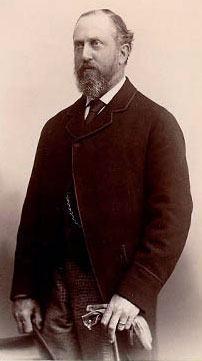 |
Colonel STANLEY who was received with cheers
said he had been asked to declare that Pier and the “extension” open and he did so
with very great pleasure. He believed he was not wrong in saying that while the
directors were content to see the commercial advantages of the Ribble, and ready to
allow the trans-oceanic steamers which they hoped to see some day going up to
Preston, pass their doors, they felt that they would not have fulfilled their duty
towards St. Annes if they had not rendered it a place where persons could embark or
disembark whether for purposes of pleasure or otherwise under all but the most
extraordinary conditions of weather, and with as much comfort as art and skill
could produce. (Applause.)
Notwithstanding that great difficulties had had to be
encountered, by the energy and perseverance of the promoters and directors and the
skill of the engineers, the work had been brought to a satisfactory impletion. He
had much pleasure in declaring the pier open for the use and benefit of the public.
(Applause.)
|
On behalf of the shareholders, directors, and others concerned in the work, Mr. Porritt proposed a
vote of thanks to Colonel Stanley for his attendance.
Mr Maxwell, in seconding the motion, said they were -highly indebted to Colonel Stanley for his
kindness. The peculiar position of our Government at the present moment must have made it a very
difficult matter indeed for the right hon. and gallant gentleman to have come down to discharge his
promise on that occasion. (Applause.) The proposition was received with “three times
three"—(Lancashire style).
Colonel STANLEY, in a brief response, said thanks were rather due to those gentlemen, the members
of the Land and Building Company, to whose energy they were indebted for the successful completion
of that work. (Applause.) On all occasions of that kind they were glad to know and to feel that
their Sovereign was associated with and interested in the successful carrying out of such
enterprises, and he thought they could do no better than signalise the opening of the Pier by
singing the National Anthem. (Applause) The suggestion of Colonel Stanley was forthwith acted
upon.
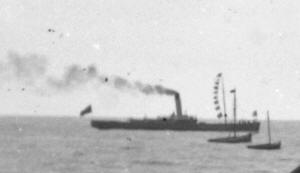
Upon the conclusion of the formal ceremony, on the invitation of the Chairman, a large number of
the invited guests took their place on board the steamer “Wellington”, which had been placed at the
disposal of the company for the day by Mr. Bickerstaffe, manager of the South Jetty, Blackpool. The
steamer, like all the other craft, was gaily decked with bunting, and presented a charming picture.
Brilliant weather with a very slight westerly wind, favoured the party and the sail was most
enjoyable. At half-past twelve the steamer put off a little to enable the passengers to witness the
launch of the lifeboat, which proved a most interesting spectacle. Shortly afterwards, the
Southport lifeboat, with the Mayor of that town on board, appeared in might and was subsequently in
tow by the "Wellington".
|






